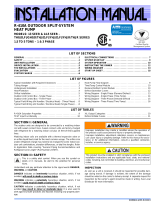
2
WARNING:
The coil is pressurized with Nitrogen. Avoid
direct face exposure or contact with valve
when gas is escaping. Always ensure
adequate ventilation is present during the
depressurization process. Any uncertainties
should be addressed before proceeding
.
NITROGEN
HEALTH
FLAMMABILITY
REACTIVITY
0 Minimal Hazard
1 Slight Hazard
1
0
0
INSTALLATION WITHIN C5 COILS
CAUTION:
To prevent damage to the unit or internal
components, it is recommended that two
wrenches be used when loosening or removing
nuts. Do not over tighten!
1. Using two wrenches, loosen the distributor and liquid line
body halves. Turn the assembly nut counter-clockwise.
2. Unscrew the swivel nut and remove the fixed orifice
from the distributor. See Figure 1 (page 3).
3. Install the thermal expansion valve between the
distributor and the 3/8 liquid line (Figure 2, page 3).
a.) Connect the liquid line to the inlet side of the valve.
b.) Connect the distributor to the outlet side of the
valve.
c.) Tighten the nut finger tight.
d.) Using a permanent marker or scribe, mark a line
lengthwise from the TXV’s female coupling nut to
the distributor body.
e.) Tighten an additional wrench flat (60°). Refer
to the marking on the coupling nut to confirm
that one wrench flat rotation has occurred.
NOTE: This final wrench flat is necessary to ensure
the formation of the metal to metal leak-proof seal.
4. Modify the close off plate by bending back a section of
the top right corner (Figure 3, page 3). NOTE: This will
allow the external equalizer and sensing bulb to reach
the refrigerant lines outside of the coil box.
5. Reinstall the close off plate and route the sensing bulb
and external equalizer through the opening.
6. Install the grommet in the suction line hole of the close
off plate. Verify the grommet is evenly aligned around
the tube and securely positioned.
7. Install the fitting assembly that is supplied with the kit
on the end of the suction line.
IMPORTANT NOTES:
• The fitting assembly must be positioned close
enough to the indoor coil so that the external
equalizer tube from the TXV can reach the fitting,
but still but still allow room for the sensing bulb to
fit flush against the suction line without hitting the
braze joint of the external equalizer.
• Position the fitting assembly on the suction line so
that the 1/4” access fitting is pointing vertically. If
the access fitting is pointed downwards, oil from
the suction line will drain into the external equalizer.
• Depending on the suction line diameter, two
reducers may need to be added to the suction line
before the fitting assembly is brazed on.
CAUTION:
It is recommended that a wet rag be wrapped
around the suction line in front of the close
off plate before applying heat. Failure to keep
components cool during brazing may result
in structural damage, premature equipment
failure, or possible personal injury.
8. Route and cut both lineset tubes to proper length in
accordance with the outdoor unit specifications. Verify
the ends are round, clean, and free of any burrs.
CAUTION:
To prevent damage to the TXV, brazing should
be done prior to the attachment of the liquid
line to the fitting assembly.
PRE-INSTALLATION
WARNING:
Shut off all electrical power to the furnace and
outdoor condensing unit before performing any
maintenance or service on the system.
WARNING:
Read the Installation Instructions supplied
with the furnace/air handler. Always observe
all safety requirements outlined in this manual
and on the furnace/air handler markings before
installing the valve.
1. Disconnect all electrical power to the furnace/air handler.
IMPORTANT NOTE: The unit may have more than
one power supply. Refer to the manufacturer’s
instructions for additional electrical information.
2. Remove coil access door from indoor unit (if applicable)
to expose the A-coil and distributor. NOTE: It may be
necessary to remove the coil from the coil case.
3. Recover all refrigerant in the system (if applicable).








